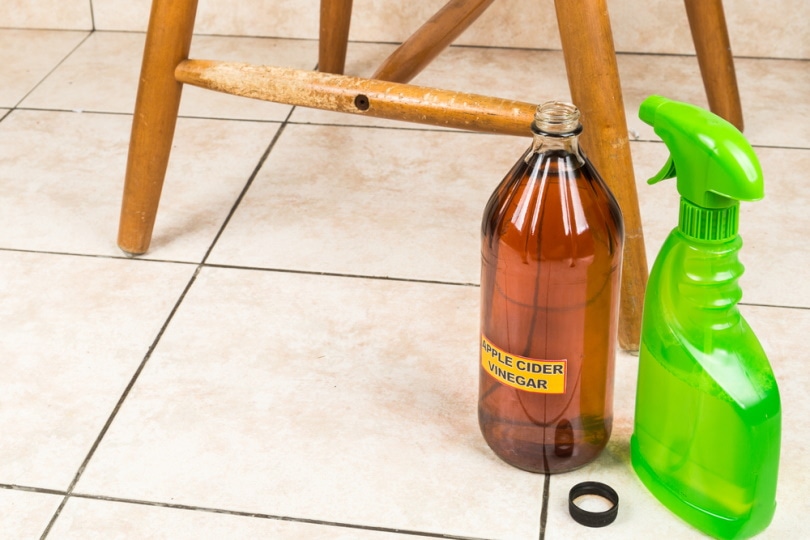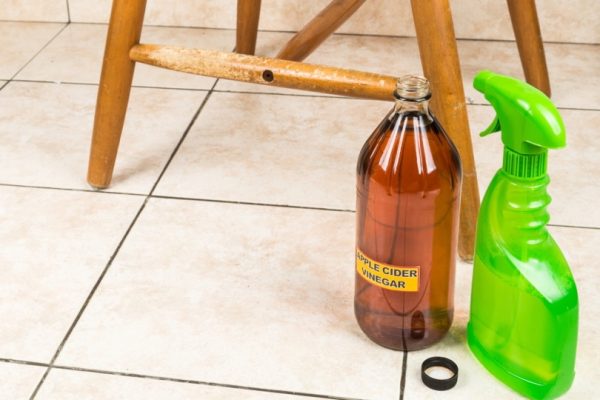Perhaps your dog is urinating in inappropriate places. Maybe one of the neighborhood canines has taken a liking to your shrubs and landscaping. A dog urine repellent is one solution you can try to get the problem under control once and for all. These mixtures rely on a pup’s sensitivity to specific smells. However, they vary in how offensive they may perceive the scents.
One reason lies with the size of a dog’s olfactory epithelium. That’s the nasal tissue that contains the animal’s scent receptors. It can vary between 18–150 cm2, depending on the breed. Hounds are well-known for their sense of smell. Others, not so much. However, if one solution doesn’t work, you have plenty of options to try to find the one that turns away the offending canine.
The Top 12 Homemade Dog Pee Repellents
1. Citronella Oil
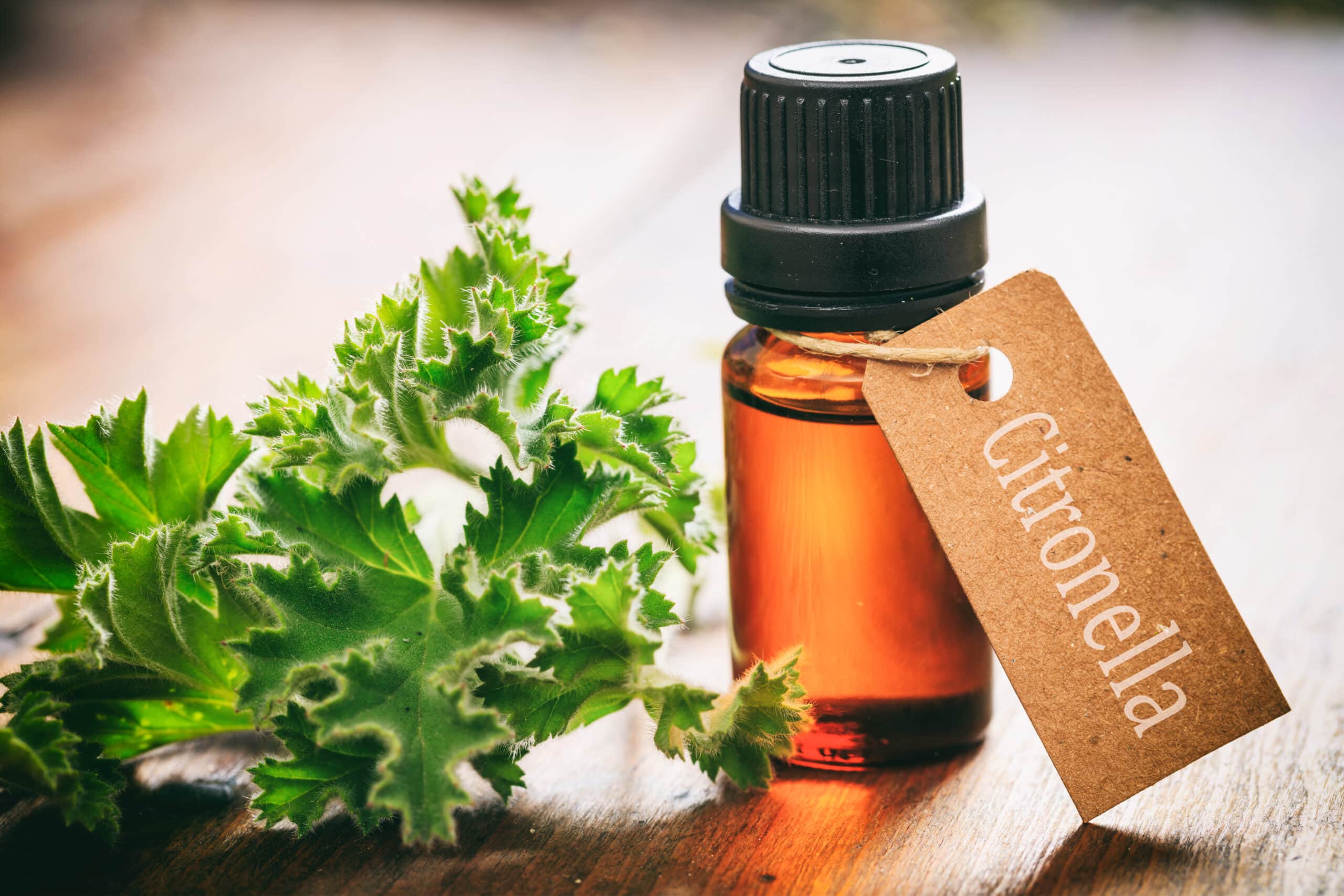
| Ease of Use: | Easy |
| Effectiveness: | Moderate |
| Placement: | Outdoors only |
Citronella oil does an excellent job of repelling, whether it’s mosquitoes or other insect pests. It also works on dogs. The reason is the intensity of its scent. Canines typically sniff out a spot before they mark it. A snoot full of citronella can get the job done, especially for pups with sensitive noses. However, it can have a similar effect on people.
Therefore, we suggest using it outside only to avoid offending anyone in the household. The good news is that it’s non-toxic to people and wildlife.
- Moderately effective
- Ready availability
- Safe for humans
- Non-toxic
- Pungent smell
2. Sour Apple Essential Oil Spray
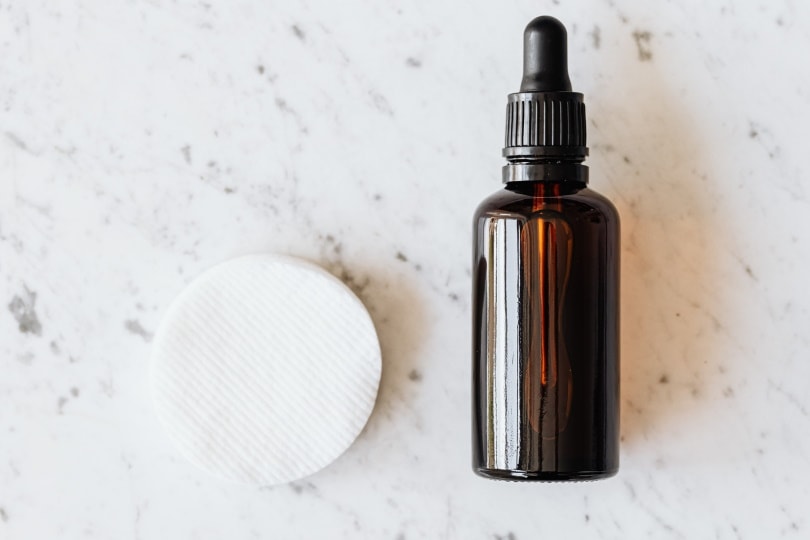
| Ease of Use: | Moderate |
| Effectiveness: | Moderate |
| Placement: | Not suitable for plants |
You can mix sour apple essential oil in a diluted solution with a neutral oil or water. Just a few drops will do. It’s not an unpleasant smell for people, but it’s not as welcome with dogs. Dilution is imperative. You should never ingest it nor let any pets lick it, either. We also recommend not spraying it directly on plants. Instead, you can apply it near them on the ground.
You can find apple essential oil online or at health food stores. It’s one of the more reasonably priced products of its type, too.
- Pleasant scent
- Affordable and easy to find.
- Toxic to ingest
- Dissipates quickly
3. Hot Chili Powder
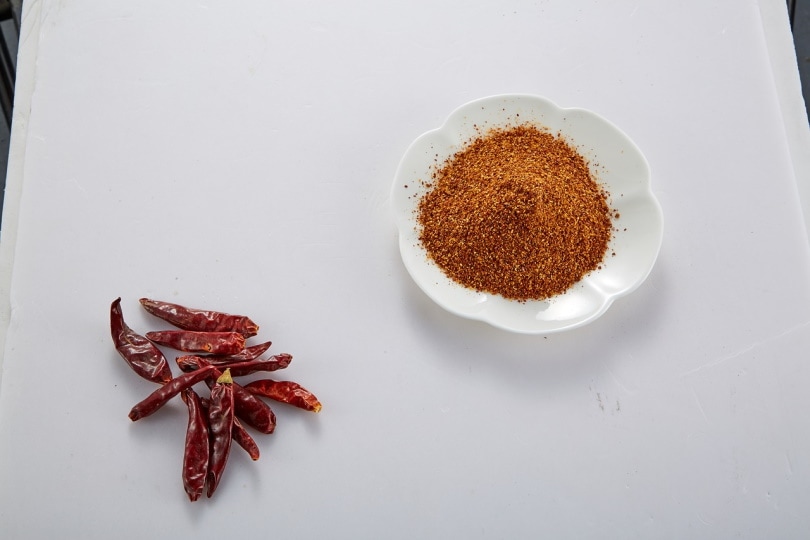
| Ease of Use: | Easy |
| Effectiveness: | Highly effective |
| Placement: | Inconspicuous spots |
If you have a bird feeder, you’re probably familiar with using hot chili powder against squirrels. It has the same effect on them as it does on people. That also applies to dogs. We suggest using it on inconspicuous spots because it can stain lighter-colored surfaces. You should also use it sparingly as it can irritate sensitive canine noses.
On the positive side, it will probably get the message across quickly and solve the problem with maybe even just one application.
- Effective
- Readily available
- Affordable
- Irritating for sensitive dogs
4. Cinnamon-Citrus Spray

| Ease of Use: | Easy |
| Effectiveness: | Moderate |
| Placement: | Avoid direct use on plants |
The cinnamon-citrus combination consists of two scents that many dogs might not like. The chances are that you’ll find it agreeable if its purpose is to repel animals. It’s essential to dilute it before using it because of the possible irritation it can cause you. This mix is volatile and can dissipate quickly, especially after precipitation, like other essential oils.
While it can be effective, it’s also essential to use as few drops as necessary because of the potential toxicity of citrus to canines and other pets.
- Pleasant scent
- Potent
- Potential toxicity of citrus
- Volatility of the oils
5. Vinegar and Citrus Spray

| Ease of Use: | Easy |
| Effectiveness: | Highly effective |
| Placement: | Avoid use on plants |
This solution uses vinegar as the carrier agent to create a scent bomb that will deter many dogs. It combines two ingredients with strong smells, especially with the white distilled vinegar. However, you can also use it with the less pungent apple cider variety and get similar results. The high acidity means that you can’t use it directly on plants.
Vinegar is volatile, too, and will dissipate quickly. Nevertheless, we suggest not spraying it downwind of any open windows.
- Effective
- Affordable
- Strong odor
- Harmful to plants
6. Lemongrass-Peppermint Solution
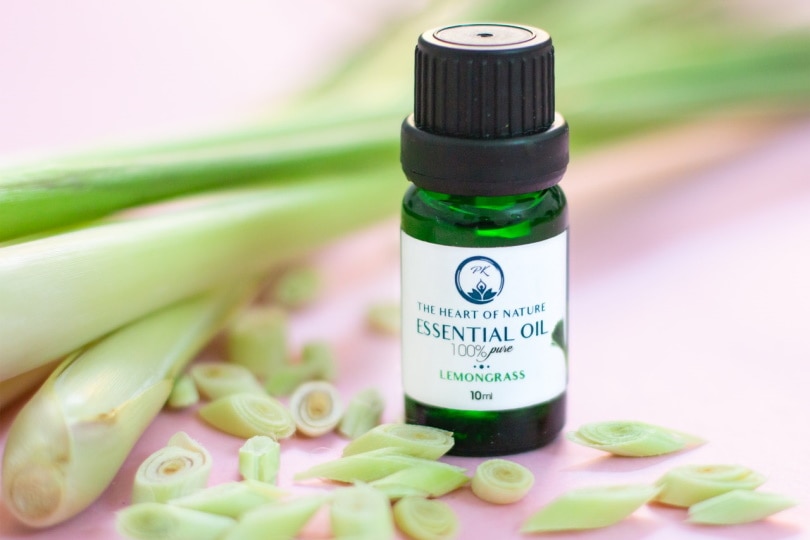
| Ease of Use: | Easy |
| Effectiveness: | Moderate |
| Placement: | Where needed, avoiding direct plant contact |
This combination is quite pleasing that you won’t think it was a repellent. The peppermint oil is easy to find. The lemongrass is a bit pricier but still readily available. As with all our recipes, it’s simply a matter of adding a few drops to a spray bottle filled with water or a neutral oil. Both ingredients have widespread use in humans and are likely safe for you to use.
Nevertheless, there is a risk of stomach upset. We also suggest not using lemongrass if you have cats. Their self-grooming may increase the chances of a reaction if they ingest too much of it. You should use this repellent in places where a dog couldn’t get to it, either.
- Pleasant scent
- Minimal health risks
- Can be overpowering
- Lemongrass is a little costly
7. Vinegar Solution

| Ease of Use: | Easy |
| Effectiveness: | Moderate |
| Placement: | Avoid direct plant contact |
Using a simple 1:4 solution of vinegar and water cuts to the chase. White distilled varieties are the least expensive, making it an affordable solution to a vexing problem. It will likely cause a dog to look elsewhere once it smells it. Nonetheless, you should avoid direct plant contact because of its acidity. You’ll also have to apply it frequently because of its volatility.
We also suggest applying it in different spots for these same reasons, particularly on bricks or patio stones.
- Inexpensive
- Effective repellent
- Unsafe for plants
- Corrosive effects
8. Rubbing Alcohol Mixture

| Ease of Use: | Easy |
| Effectiveness: | Moderate |
| Placement: | Out of reach of pets |
A dilute rubbing alcohol mixture works similarly to vinegar by creating an intense scent that will keep dogs from your yard. Like many of our solutions, it’s also essential to spray it out of the reach of any pets because of its potential toxicity if ingested. After all, the purpose of these repellents is to keep dogs away from your yard and not to encourage them to keep coming back to it.
The solution is volatile like the vinegar one. However, it does linger a bit longer. Since it’s water-based, you’ll have to reapply it after any precipitation.
- Inexpensive
- Strong scent for optimal repellency
- Volatile
- Disagreeable to some people
9. Citrus Water Spray

| Ease of Use: | Easy |
| Effectiveness: | Fair to moderate |
| Placement: | Out of reach of pets |
You can use any kind of citrus essential oil, such as orange, lemon, or lime. Any of them will do the job. You only need a few drops. Many dogs and cats dislike the scent, making it an effective solution. However, it also depends on the sensitivity of the animal. Bear in mind that citrus can cause stomach upset and skin irritation in pets. Therefore, we suggest spraying it out of any dog’s reach.
The great thing about this solution is that you’ll likely find it pleasant and refreshing. Essential oils linger longer, too. Nonetheless, the reapplication advice still applies.
- Long-lasting
- Pleasing scent
- Potential toxicity
Another good option—if you’re willing to go for a commercial product—is an enzyme spray. These products are specifically designed to deal with dog and cat pee smells and stains. What pet owner doesn’t need that?
If you're looking for an all-in-one enzyme cleaner, we highly recommend the Hepper Advanced Bio-Enzyme Pet Stain & Odor Eliminator Spray.
- ADVANCED ENZYMATIC CLEANER - Penetrates the most stubborn smells and stains at the deepest molecular...
- FOR ANY MESS, ON ANY SURFACE - This pet odor eliminator cleans your carpets, floors, furniture,...
- FRESH, NATURAL ODOR - Our unique formulation doesn't rely on dangerous or unpleasant chemical...
It eliminates tough stains and odors easily. Plus, it comes with a 100% satisfaction guarantee! Click here to order now.
At Dogster, we’ve admired Hepper for many years, and decided to take a controlling ownership interest so that we could benefit from the outstanding products of this cool pet company!
10. Black Pepper Oil

| Ease of Use: | Moderate |
| Effectiveness: | Moderate |
| Placement: | Out of reach of pets |
Black pepper will likely cause the same reaction in a dog as it does for you if you get a good whiff of it. This one takes some prep. You’ll have to simmer a tablespoon of crushed black peppercorns in ½ cup of a neutral oil for a few minutes and let it cool. Then, strain it. The solution is effective and will deter a curious pup. However, the oil can go rancid quickly unless you keep it in the fridge.
We suggest spraying it someplace inconspicuous where a dog can’t get near it. It can stain some surfaces.
- Pungent smell
- More prep
- Short shelf life
- Staining properties
11. Chili-Black Pepper Oil
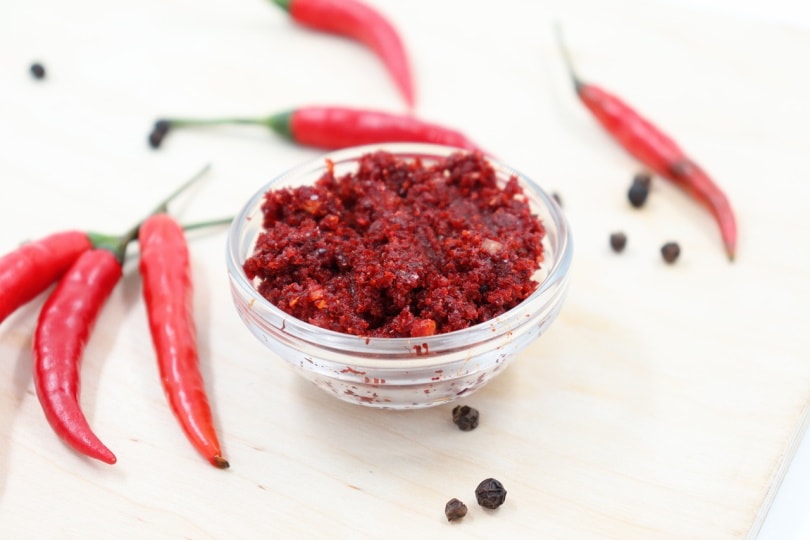
| Ease of Use: | Moderate |
| Effectiveness: | Moderate |
| Placement: | Inconspicuous surfaces only |
This solution combines two effective ingredients to ramp up the repellency factor. Both work well on their own and together. You can follow the instructions for the black pepper oil and add a tablespoon of crushed red pepper flakes. Be careful not to let the oil boil. It’ll release irritating fumes that you certainly don’t want in your house.
The chili adds a staining element to the mix, so mind where you spray it. It also can cause possible skin irritation if a dog encounters it.
- Effective for most dogs
- Can stain some surfaces
- Careful prep necessary
12. Citrus Peels

| Ease of Use: | Easy |
| Effectiveness: | Fair |
| Placement: | As needed, away from the house and out of reach of pets |
Sometimes, it’s best to get down to brass tacks and go to the source. You can use any kind of citrus peels. We suggest tying them in a length of cheesecloth and hanging them near any trouble spots. The effectiveness depends on the animal’s natural aversion to these scents. It’s essential that it’s out of the reach of any pets because of the toxicity of citrus fruits.
We also recommend placing it someplace away from your home since it can attract other pests, such as ants and rodents.
- Simple solution
- Pleasing scent
- Citrus toxicity
- Possible pest attractant

How to Correct the Behavior
Of course, the best solution would be the prevention or elimination of the problem. The former is the best of the two. Dogs will mark their territory as part of becoming sexually mature. If you’re not planning on neutering your pet, it’s a matter of diligent training to ensure your pup knows where it can and cannot urinate. We’re big fans of exercising our pets a lot to wear them down for sleep in the house.
Positive reinforcement is the best teacher. A treat when your dog does what it’s supposed to do is a powerful motivator. Crate training is also an effective way for your pet to learn to keep its space clean. It draws on their instincts not to soil the place where they sleep and are most vulnerable because of it.
If you want to keep your dog from your landscaping, a motion-sensor sprinkler will get the point across in no uncertain terms. An electric fence is another option that you can use if you need to protect more extensive areas.
Conclusion
A dog urine repellent is one way to get control of an unpleasant situation before it becomes a problem. Fortunately, you have several options for making a DIY spray to correct it. However, even commercial products aren’t the best solution for a persistent or extensive issue. Prevention is the smartest way to deal with it. If you need a one-off repellent, you’ll find that any of these mixtures will help.
Featured Image Credit: ThamKC, Shutterstock
Contents
- The Top 12 Homemade Dog Pee Repellents
- 1. Citronella Oil
- 2. Sour Apple Essential Oil Spray
- 3. Hot Chili Powder
- 4. Cinnamon-Citrus Spray
- 5. Vinegar and Citrus Spray
- 6. Lemongrass-Peppermint Solution
- 7. Vinegar Solution
- 8. Rubbing Alcohol Mixture
- 9. Citrus Water Spray
- 10. Black Pepper Oil
- 11. Chili-Black Pepper Oil
- 12. Citrus Peels
- How to Correct the Behavior
- Conclusion

